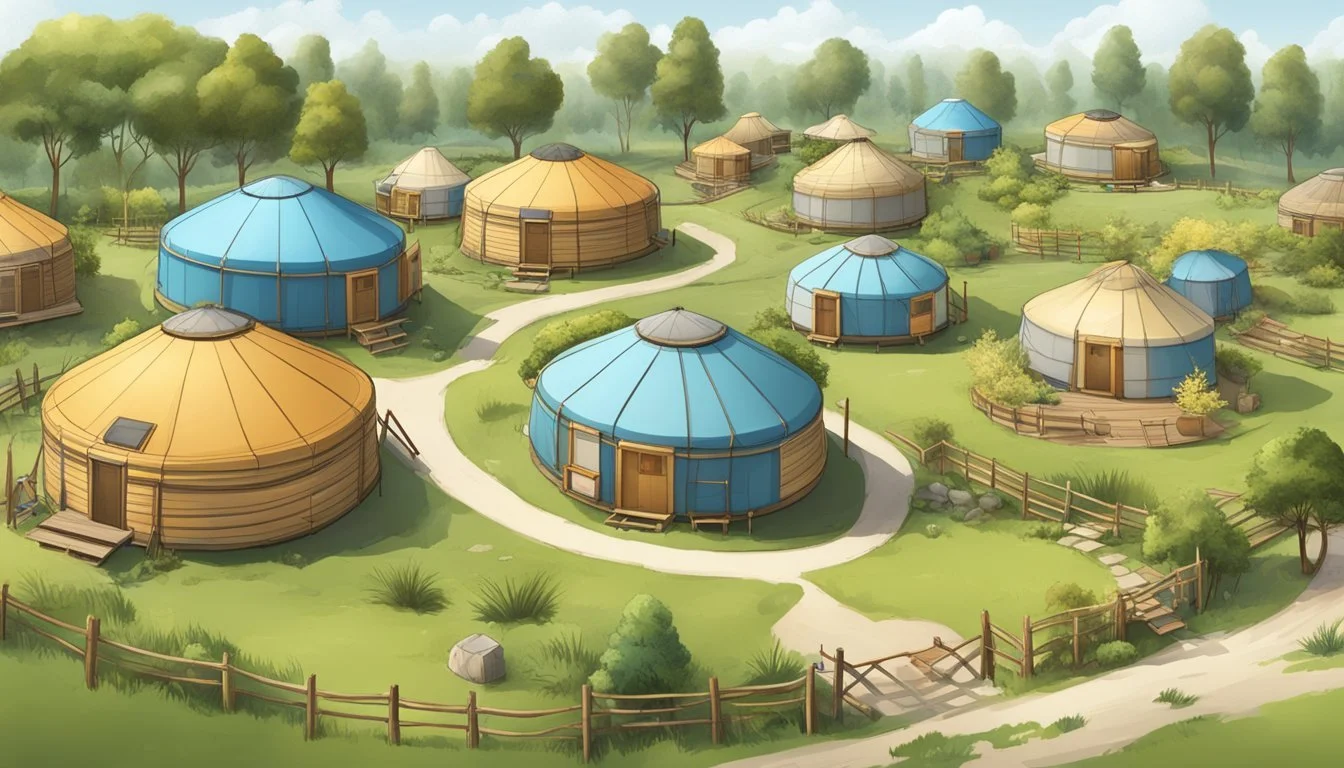Free Land for Yurts
Exploring Sustainable Living Options
Thinking about a sustainable and affordable alternative housing solution? Living in a yurt might be just what you need. Yurts, grounded in traditional nomadic cultures of Asia, have evolved into a modern choice for those seeking simplicity and closer connections to nature. There are opportunities to find free land for yurts, enabling a cost-effective lifestyle while embracing sustainability.
Finding free land for yurts can provide a unique pathway to achieve a debt-free and eco-friendly lifestyle. While it requires some creativity and flexibility—considering factors like utilities and climate—you'll find states like Washington and Colorado to be yurt-friendly. Legally living in a yurt can vary by location, but the rewards of stepping into a yurt lifestyle can be immensely fulfilling.
The charm of yurt living lies in its simplicity and connection to the environment. These circular, dome-like structures are not only affordable but also adaptable, making them an ideal choice for those committed to a sustainable life. From harnessing solar energy to engaging in minimalistic living, modern yurt dwellers often find innovative ways to live comfortably and responsibly.
Historical Background of Yurts
Yurts have a rich history rooted in Central Asian nomadic cultures, evolving over centuries to suit modern lifestyles. This section explores their origins and transformation.
Origin in Central Asia
Yurts, also known as gers in Mongolia, originated in Central Asia over three thousand years ago. Nomads in regions like Mongolia and Siberia depended on these circular structures for their mobility and resilience. Ancient rock etchings from the Bronze Age in Siberia depict early yurt-like dwellings.
Crafted from wooden frames and covered with felt made from sheep's wool, traditional yurts provided insulation and warmth. This adaptability to harsh climates made them ideal for nomadic tribes. These durable structures were not just shelters but also symbolic cultural artifacts reflecting the harmonious relationship between humans and their environment.
Evolution to Modern Yurts
Modern yurts have retained the original design's core elements while incorporating contemporary materials and construction techniques. Since the 1960s, there has been a significant revival and innovation, particularly in the United States. Figures like David Raitt have modernized yurt construction, integrating more durable and sustainable materials.
Today's yurts are custom-built with options for insulation, plumbing, and electricity, making them suitable for permanent residences. These innovations have expanded their appeal beyond traditional nomadic use to eco-friendly housing solutions. As they gain popularity, modern yurts blend historical significance with contemporary needs, creating versatile living spaces that resonate with sustainability and efficiency.
Anatomy of a Yurt
A yurt is a unique and efficient housing structure with a distinct set of components and materials. The framework, insulation, and choice of materials all contribute to its functionality and comfort.
Structural Components
A yurt's structure is primarily composed of a wooden lattice, roof poles, a roof ring, and a fabric covering. The wooden lattice forms the circular wall framework, offering flexibility and strength.
Roof Poles: These stretch from the top of the lattice walls to the central roof ring, creating the pitched roof.
Roof Ring: This central hub not only supports the roof poles but also serves as a base for the roof dome.
Roof Dome: Typically made of clear material, it provides natural light and ventilation.
Doors and Windows: Yurts often feature a single door and strategically placed windows for additional light and airflow.
Materials and Insulation
Ensuring a yurt is well-insulated is crucial for comfort in different climates. The exterior covering typically consists of durable canvas.
Canvas: Often weather-resistant, it acts as the primary barrier against the elements.
Walls: Layers of felt or other insulating materials can be added to the canvas walls for heat retention.
Insulation: Besides felt, some yurts use modern insulation materials.
Additional Elements: These might include wooden flooring for added stability and warmth, and insulating layers beneath the canvas roof to maintain interior temperatures.
By carefully selecting and combining these materials, a yurt can provide a sustainable and comfortable living space.
Yurt Construction and Setup
Constructing a yurt involves careful planning and execution, including selecting a suitable site, building a solid foundation, and installing necessary utilities. Each step is crucial for ensuring the yurt is safe, practical, and comfortable.
Site Preparation
Choosing the right site is vital for yurt stability and longevity. The site should be flat, well-drained, and free from large roots or rocks. Avoid areas prone to flooding. Clear the land of vegetation and debris.
Next, create a base with a gravel pad or a concrete slab to prevent moisture from seeping into the yurt. These materials provide a stable and durable foundation. Proper drainage around the site helps prevent water build-up.
Securing the necessary permits is essential before construction. Local regulations vary, so check with municipal offices. Obtaining permits ensures compliance with building codes and zoning laws.
Building the Yurt
Building a yurt starts with assembling the base. A wooden platform or deck is common, with treated lumber preferred for durability. The platform must be level and secured to withstand weather conditions.
The next step is setting up the yurt frame. This includes the lattice wall, central ring, and rafters. Using a high-quality yurt kit simplifies the process. The lattice wall opens out to create the yurt's circular shape.
Securing the fabric cover over the frame is critical, ensuring it’s tight and wrinkle-free to prevent damage. The cover usually consists of multiple layers, including insulation and waterproofing.
Utilities Installation
Installing utilities makes the yurt functional and livable. Solar panels can provide electricity if traditional hookups are unavailable. Choosing energy-efficient appliances reduces the power load on off-grid systems.
For plumbing, composting toilets and greywater systems offer sustainable solutions. Running water may require connecting to a nearby source or installing a rainwater harvesting system.
Heating and cooling are crucial for comfort. Options include wood stoves, propane heaters, or electric heaters for warmth. Insulation helps maintain temperature. Ventilation and window design aid in natural cooling during warmer months.
Legal Considerations
When considering living in a yurt, it is essential to understand the legal aspects involved. This involves adhering to zoning laws, obtaining necessary permits, ensuring compliance with building codes, and addressing insurance and tax matters.
Zoning Laws and Regulations
Zoning laws determine where you can place a yurt. Each municipality has rules regulating land use, and you'll need to verify if they allow yurts for permanent or temporary residence.
Building codes will dictate the structural requirements for yurts. These may include aspects such as fire safety, insulation, or wind resistance. Permits are often required when setting up a yurt. These might include building permits or occupancy permits, which ensure that the yurt meets local regulations.
Key Steps:
Check local zoning laws: Verify if yurts are allowed.
Understand building codes: Ensure compliance for safety and structural integrity.
Obtain necessary permits: Secure all required documentation.
Insurance and Taxes
Insurance for yurts can be tricky. Standard home insurance may not cover yurts, so specialized insurance might be necessary to protect your investment. It's important to look for policies that cover both structural damage and personal property within the yurt.
Taxes on yurt living can vary. Property taxes might apply differently depending on whether the yurt is considered a temporary or permanent structure. Local tax regulations will influence how much you pay annually.
Important Considerations:
Research insurance options: Look for providers that offer yurt-specific coverage.
Understand tax implications: Verify how local laws categorize yurts for tax purposes.
Keep records: Maintain thorough documentation of all permits and insurance policies.
Lifestyle and Practicalities
Yurt living offers a unique blend of simplicity and connection to nature. This section dives into the daily life, mobility, and challenges one may face living in a yurt.
Living in a Yurt Full-time
Living in a yurt full-time requires adapting to a minimalist lifestyle. Many people who choose this lifestyle enjoy the freedom from material possessions and the ability to connect deeply with nature. Yurts can serve as year-round homes, offering comfort across seasons.
Establishing routines that adapt to seasonal changes is crucial. It often involves joining local sustainable living and minimalist communities. These winterized yurts can be fitted with heating systems to handle cold climates, making them a viable year-round home.
Limited space means prioritizing activities that fit within the compact living area. With open floor plans, the space can be quite versatile, yet privacy can be an issue. Some residents build partition walls or use curtains to create private areas.
Accessibility and Mobility
One of the main appeals of yurt living is its mobility. Yurts are inherently portable and can be moved relatively easily compared to traditional homes. This feature is ideal for nomads or those who want the flexibility to change their living location.
Transporting a yurt requires careful planning, as it involves dismantling the structure and reassembling it at the new site. This flexibility often allows for placing yurts in remote, scenic locations where traditional housing might not be possible.
Accessibility also depends on local zoning laws. Some regions have more lenient rules for portable structures, while others have strict regulations that could limit where yurts can be placed. Understanding local laws is essential for those considering this housing option.
Challenges and Solutions
Yurt living comes with its own set of challenges, primarily related to extreme weather conditions and limited space. Extreme temperatures can make living in a yurt difficult without proper insulation and heating or cooling systems.
Challenges:
Temperature control
Lack of privacy
Limited space
Solutions:
Installing robust heating/cooling systems
Using modular furniture to maximize space
Adding extra insulation for weatherproofing
Privacy concerns can be mitigated by creative interior arrangements or enhanced through remote yurt placements, away from densely populated areas.
Essentially, while yurt living poses some difficulties, with thoughtful planning and adaptability, these issues can be managed to create a fulfilling living experience.
Environmental Impact
Yurts offer a sustainable and eco-friendly housing option due to their minimal resource usage and potential for renewable energy integration. Their design supports a more environmentally responsible way of living.
Eco-friendliness and Sustainability
Yurts have a low environmental footprint as they use fewer building materials and resources compared to conventional housing. This means less deforestation and reduced manufacturing emissions.
Material Usage:
Natural Materials: Yurts often use sustainable resources like wood and canvas.
Minimal Waste: Construction results in less waste.
Yurt dwellers can also integrate renewable energy systems, such as solar panels and wind turbines, to power their homes. This further reduces their reliance on non-renewable energy sources. Additionally, yurts' efficient design can minimize heating and cooling needs, leading to lower energy consumption.
Off-the-Grid Potential
Yurts are suitable for off-the-grid living, making them an excellent choice for those seeking independence from traditional utility services. They can be self-sufficient with the installation of solar power systems, wind turbines, and rainwater harvesting setups.
Benefits of Off-the-Grid Living:
Energy Independence: Reduces reliance on public utilities.
Cost Savings: Lower utility bills and maintenance costs.
With the capability to generate their own power and manage water resources, yurts provide a robust framework for a sustainable, off-the-grid lifestyle. This independence aligns well with the goals of reducing environmental impact and promoting eco-friendly living.
Cultural and Social Aspects
Living in a yurt encompasses significant cultural and social dimensions. Rooted in nomadic traditions, yurts provide a unique connection to nature and are central to the modern alternative housing movement.
Community and Connection to Nature
Yurts, originating from Central Asian nomadic cultures, offer an intimate relationship with the environment. Their circular shape and portable design foster a strong connection to nature.
The open-plan interiors encourage communal living, making it easier for occupants to engage with each other. In many yurt communities, shared activities such as gardening and maintenance enhance social bonds. Minimalism is a key aspect, as the limited space promotes a simpler, more interconnected lifestyle.
The lifestyle aligns well with the tiny house movement, which values sustainability and a minimalist lifestyle. By living in yurts, individuals often embrace higher environmental consciousness and reduced carbon footprints.
Alternative Housing Movement
The shift towards alternative housing options, including yurts, has gained momentum as people seek sustainable and economical living solutions. This trend aligns with the broader tiny house movement, which advocates for downsizing and simplicity.
Yurt living appeals to those who desire a minimalist lifestyle away from traditional housing constraints. Building or purchasing these circular dwellings can be more affordable compared to conventional homes.
Individuals within this movement prioritize efficiency, eco-friendliness, and community-centered living. Such choices reflect a growing societal shift towards more mindful and sustainable ways of living, integrating modern needs with historical practices. Yurts thus symbolize a bridge between past traditions and contemporary housing challenges.
Financial Aspects of Yurt Homes
Living in a yurt can offer significant cost advantages compared to traditional homes, especially when one considers initial investment, maintenance, and potential resale value.
Cost Comparison with Traditional Homes
Initial costs for a yurt are considerably lower than traditional homes. Prefab yurt kits range from $6,000 to $20,000, while custom-designed yurts can cost $15,000 to $30,000. This is a fraction of the cost of building a standard house, which can easily exceed $200,000.
Land purchase and site preparation for yurts can also be more affordable. Land prices can vary greatly, but smaller plots often used for yurts can be cheaper. Site preparation, including groundwork and utilities setup, typically ranges from $2,000 to $4,000, whereas traditional homes require more extensive groundwork leading to higher costs.
Investment and Resale Value
From an investment perspective, yurts offer several benefits. The lower initial costs mean that more people can afford to invest in them without taking on substantial debt. This affordability can appeal to those looking to enter the real estate market on a tight budget.
Resale value of yurts can vary. While they may not appreciate in value as much as traditional homes, they can still hold value well, especially in markets where alternative housing is popular. Proper maintenance and unique customization can enhance a yurt's appeal, potentially increasing its resale value within niche markets.
Keeping these financial considerations in view, yurts represent a viable and affordable housing option for many.
Adaptability and Customization
Yurts are renowned for their adaptability and customization, offering a unique living experience that can be tailored to individual needs and preferences. They provide various customization options that make them highly functional and aesthetically pleasing.
Design Flexibility and Expansion
Yurts come in different sizes, allowing owners to choose the one that suits their needs best. Smaller yurts might be around 12 to 20 feet in diameter, while larger ones can reach up to 30 feet or more.
Expansion is another significant advantage, as multiple yurts can be connected through hallways or covered walkways, creating a larger living space. This modular approach makes it easy to expand living areas over time without a complete overhaul.
The design of a yurt also permits variability in materials and finishes, enabling owners to choose options that match their lifestyle and priorities. Interior walls can be added or removed to create separate rooms or open, shared spaces, enhancing both privacy and communal areas.
Interior Design and Personalization
Personalizing the interior of a yurt allows for a high degree of creativity and functional design. The circular structure can be outfitted with custom interior walls to create distinct living areas such as bedrooms, kitchens, and bathrooms.
Furniture arrangement and décor can vary widely, with some opting for minimalist designs that emphasize the natural beauty of the structure, while others may opt for a more elaborate aesthetic.
Lighting and heating elements can be customized to enhance comfort, whether through solar tubes for natural light or wood stoves for a cozy atmosphere. Interior customization also includes choosing finishes for floors and walls, which can range from wooden planks to woven mats, each adding a unique touch to the living space.
The combination of design flexibility and personalized interior options make yurts a versatile choice for those looking for an alternative housing solution.
Yurt Providers and Resources
Finding the right yurt provider and having access to the right resources can greatly enhance the experience of living in a yurt. The following sections dive into key manufacturers and DIY kits and provide valuable resources for prospective yurt owners.
Manufacturers and DIY Kits
Several well-known manufacturers specialize in high-quality yurts. Examples include Living Intent Yurt Company and Pacific Yurts. These companies offer both prefab kits and custom builds with prices ranging from $6,000 to $30,000, depending on size and features.
DIY kits allow for a more hands-on approach. They usually cost less but require more time and effort. Basic kits generally contain a frame, cover, and hardware. Essential tools and additional materials might need to be sourced separately.
Choosing between manufacturers and DIY kits depends on individual preferences. While prefab kits ensure professional craftsmanship, DIY kits provide a sense of accomplishment and savings. Prospective buyers should weigh the pros and cons, including budget, time, and required skills.
Resources for Prospective Owners
Prospective yurt owners should explore several resources. Online forums, like Yurt Living Forum, offer community support and advice. Websites such as Yurts.com provide detailed guides on installation, maintenance, and utility setups.
For those considering off-grid living, learning about renewable energy options is crucial. Solar panels, composting toilets, and water collection systems are popular choices. Local zoning laws should be reviewed to ensure compliance with residential codes.
Financial planning is also vital. Initial investments can range significantly. Buyers must budget for the yurt itself, land acquisition, and site preparation. Investigating any hidden costs, such as permits and insurance, can prevent future surprises.










